Table of Contents
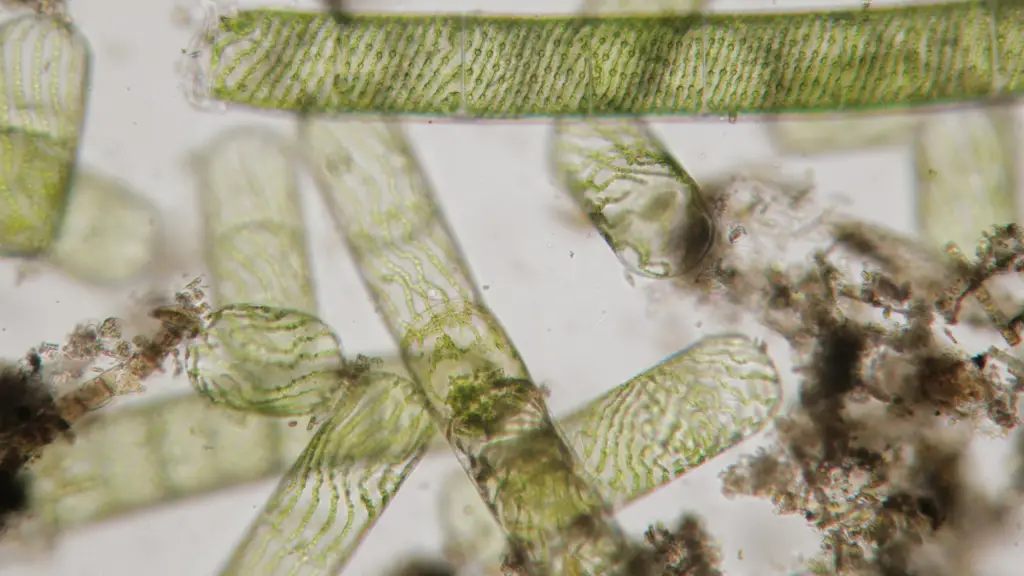
Spirogyra is a genus of filamentous green algae that belongs to the Chlorophyta phylum. It is commonly found in freshwater habitats and is known for its spiral chloroplasts that give it its distinctive appearance. In this article, you will learn about the definition and structure of Spirogyra, as well as its reproduction process. A detailed diagram will also be provided to help you understand the different parts of the organism and its unique features. Whether you are a student studying biology or just interested in learning about the natural world, this article will provide you with an in-depth look at Spirogyra and its significance in the ecosystem. Get ready to dive into the fascinating world of algae and discover all about Spirogyra!
What is Spirogyra? – Definition of Spirogyra
Spirogyra is a green alga that is predominantly found in freshwater as clumps. These are also known as Mermaid’s hair or Water silk.
- Spirogyra are green, free-floating algae found in ponds, lakes, and other freshwater settings. Spirogyra are typically referred to as “water silk or pond silk.”
- They have a vegetative structure that is unbranched and filamentous. They are named for their aesthetically pleasing spiral chloroplasts. There are over 400 species of Spirogyra.
- The genus Spirogyra derives its name from the distinctive spiral chloroplasts found in algal cells.
- Spirogyra are photosynthetic and significantly contribute to total carbon dioxide fixation. They boost the oxygen levels in their environment. Numerous aquatic organisms eat them.
- Each cell of the filaments has a huge central vacuole in which the nucleus is suspended by thin cytoplasmic filaments. The chloroplasts round the vacuole in a spiral formation.
- The slippery feel of algae is due to the cell wall, which consists of an inner layer of cellulose and an outside layer of pectin.
- In spring, Spirogyra grows underwater. When there is sufficient sunlight and warmth, they produce vast quantities of oxygen that are stored as bubbles between the filaments.
- Spirogyra is classed under Chlorophyta due to its chlorophyll content.
- Spirogyra’s vegetative structure is an unbranched filamentous thallus. Each cylindrical cell of the multicellular thallus is connected end to end.
- They range in width from 10-100 m to several centimetres in length. Due to the mucilage coating around the filament, they appear like a slimy mass.
- The cell wall is composed of two layers, namely cellulose and pectose. Due to the dissolution of pectose in water, the mucilage layer is slimy. There is a nucleus, cytoplasm, a huge central vacuole, and spiral chloroplasts in each cell.
- Chloroplasts are spirally organised and ribbon-shaped. There may be one to sixteen chloroplasts in a cell. Chloroplast contains an array of pyrenoids. Pyrenoids store protein and carbohydrates.
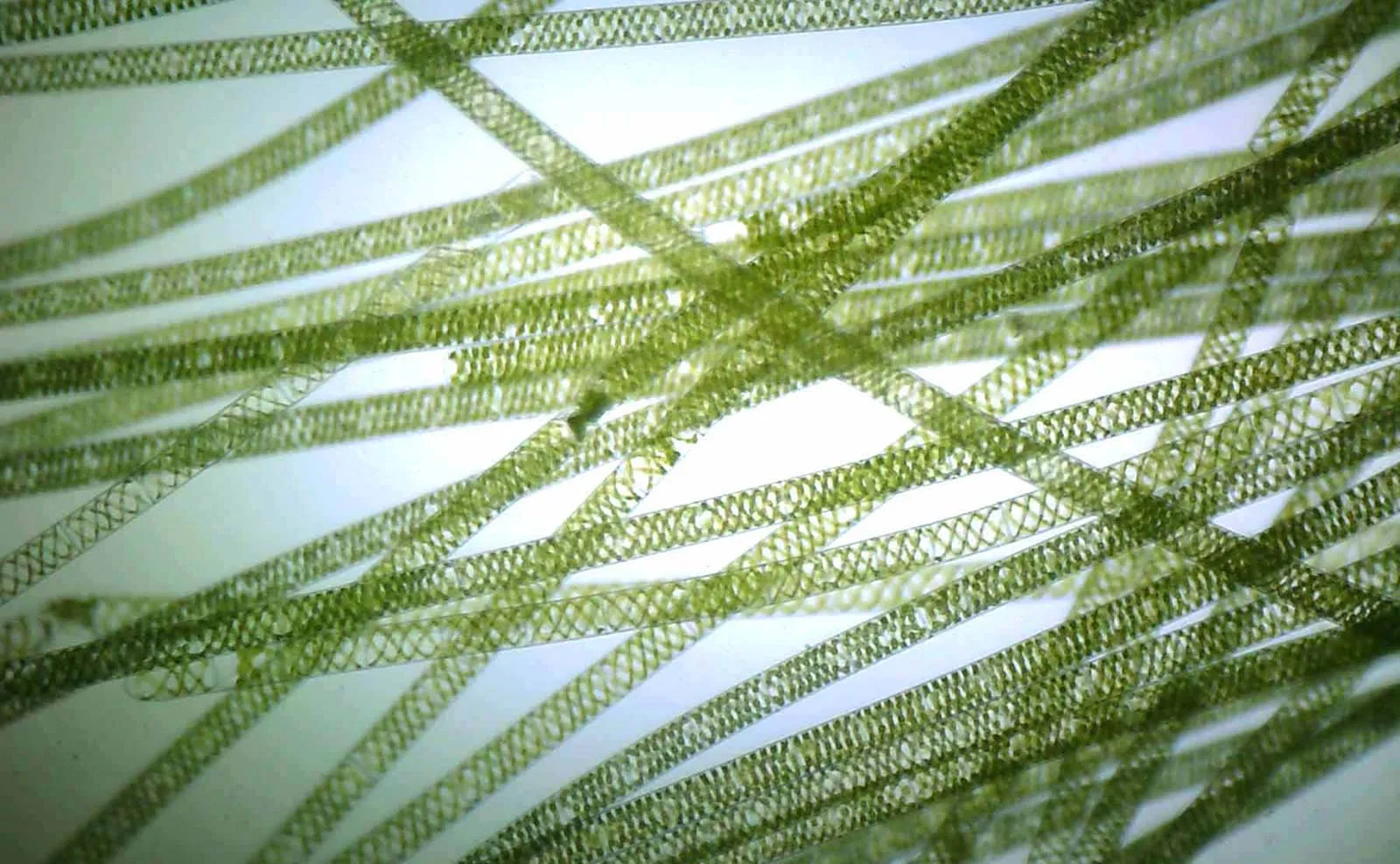
Characteristics of Spirogyra
Spirogyra is a genus of filamentous green algae that are commonly found in freshwater habitats. Here are 10 characteristics of Spirogyra:
- Filamentous Structure: Spirogyra consists of long, cylindrical filaments that are composed of many cells stacked one on top of the other.
- Chloroplasts: Each cell of Spirogyra contains several chloroplasts, which are the organelles responsible for photosynthesis.
- Cell Wall: The cells of Spirogyra are surrounded by a flexible cell wall made of cellulose.
- Nucleus: Each cell of Spirogyra contains a single, large nucleus.
- Reproduction: Spirogyra reproduces both sexually and asexually. In sexual reproduction, gametes are formed and fuse to form a zygote. In asexual reproduction, fragments of the filament break off and form new individuals.
- Resilience: Spirogyra is able to tolerate a wide range of environmental conditions, including changes in temperature, light intensity, and water chemistry.
- Nutrient Uptake: Spirogyra is able to absorb nutrients from the water through its cell membrane.
- Ecological Importance: Spirogyra is an important primary producer in many freshwater ecosystems, providing food for a variety of herbivores and detritivores.
- Habitat: Spirogyra is found in a variety of freshwater habitats, including ponds, lakes, streams, and rivers.
- Taxonomy: Spirogyra is classified as a member of the division Chlorophyta, a group of green algae that are important for their role in photosynthesis and as primary producers in aquatic ecosystems.
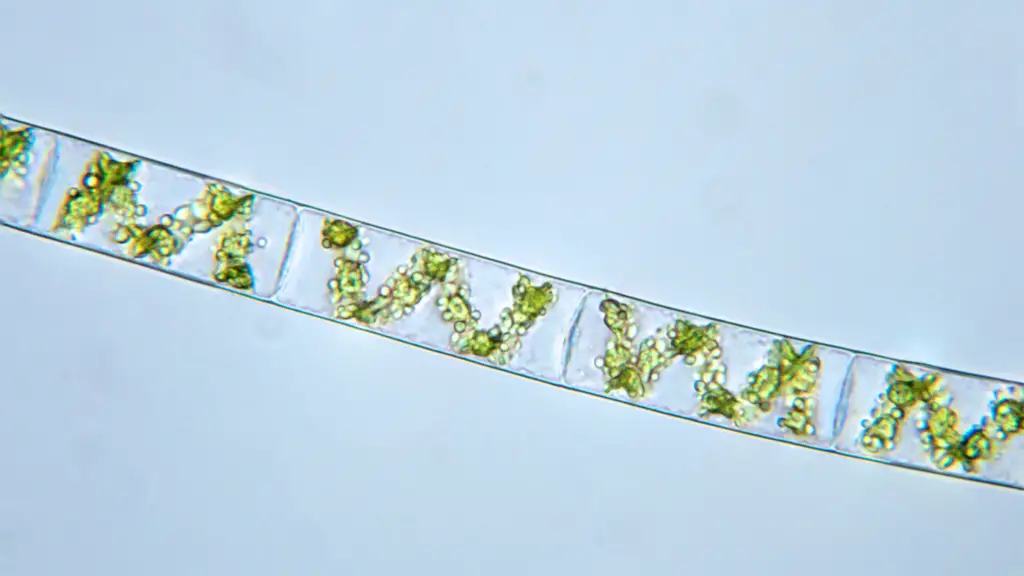
Classification of Spirogyra
About 400 species of Spirogyra are found in various freshwater bodies across the globe. E. Fritsch (1935) described or proposed the following taxonomic classification of Spirogyra in his book “The Structure and Reproduction of Algae”:
| Domain | Eukaryota |
| Kingdom | Plantae |
| Phylum | Chlorophyta |
| Class | Zygnematophyceae |
| Order | Zygnematales |
| Family | Zygnemataceae |
| Genus | Spirogyra |
Habitat of Spirogyra
- Spirogyra (Chlorophyta) is a type of green algae that can be found in a variety of environments, from small, stagnant water bodies to larger rivers and streams.
- It is also a component of the vegetation that grows along the shores of major rivers and lakes.
- The filamentous Spirogyra often gathers into large masses that float in the water near streams and ponds, propelled by the oxygen bubbles produced during photosynthesis.
- You can also find these in short-lived ponds that fill up during rainy periods and then dry up when the weather becomes dry.
- These are an important aspect of the aquatic ecology since they are photosynthetic and use chlorophyll as their photosynthetic pigment.
- A few species of Spirogyra can be seen floating in groups of green in slow-moving rivers and streams.
Morphology or Structure of Spirogyra
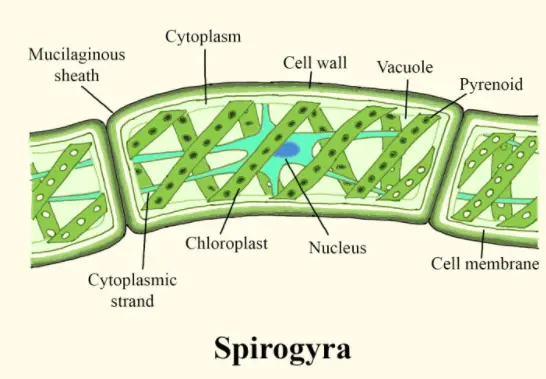
- Spirogyra’s vegetative structure is an unbranched filamentous thallus.
- Each cylindrical cell of the multicellular thallus is connected end to end.
- They are 10-100 m wide and can reach lengths of several centimetres.
- Due to the mucilage coating around the filament, they appear like a slimy mass.
- The cell wall consists of two layers: cellulose on the inside and pectose on the outside. The mucilage coating is caused by the breakdown of pectose in water.
- There is a nucleus, cytoplasm, a huge central vacuole, and spiral chloroplasts in each cell.
- Chloroplasts are spirally organised and ribbon-shaped. There may be one to sixteen chloroplasts in a cell.
- Chloroplast contains an array of pyrenoids. Pyrenoids store protein and carbohydrates
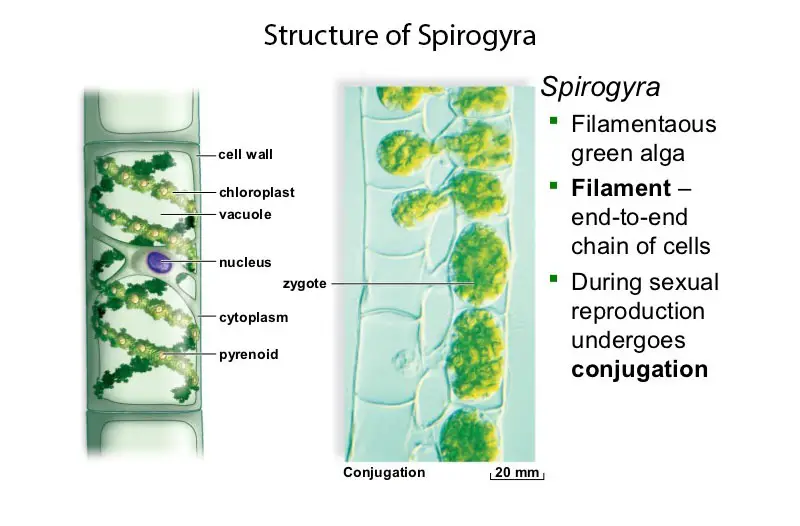
Cultural characteristics of Spirogyra
Most algae may be identified based only on their morphological traits. But it’s possible that identifying algae would also require knowledge of some of their cultural quirks.
- Green algae, including Spirogyra, can be grown in BG-11 medium. Spirogyra species can also thrive in Bold’s Basal Medium, which contains triple nitrate and vitamins.
- It takes several weeks to get a dense Spirogyra culture from a single cell, and even longer when compared to the growth rate of bacteria.
- The algal suspension may have phosphate and nitrate added to it at varying amounts twice weekly during cultivation.
- Spirogyra exhibits the typical sigmoidal growth characteristics, which involve a brief lag phase followed by exponential expansion.
- Spirogyra’s mucilage production serves as a defence mechanism against epiphytes, and as the culture density rises, the medium may turn dark green and the supernatant of centrifuged samples is found to become progressively red and viscous.
- Green clusters of spirogyra grow from all over the plates or bioreactors as the spirogyra spreads.
- The filaments can be anywhere from 100 nm to 600 nm in length and 10 nm to 100 nm in width, depending on the species.
- Moreover, the gametangia and zygospores’ shapes may vary from species to species, adding another layer of complexity to the process of species identification.
Life Cycle of Spirogyra
The life cycle of Spirogyra is a fascinating process that occurs in three ways, including vegetative, asexual, and sexual reproduction. This article will focus on exploring the life cycle of Spirogyra and how it occurs via different methods.

Vegetative and Sexual Cycles: The Most Common Methods – The vegetative and sexual cycles are the most common methods of the life cycle of Spirogyra, while the asexual cycle is less common. Both vegetative and sexual cycles play a crucial role in the survival of the species.
Alternation of Generation: A Key Characteristic – A key characteristic of the life cycle of Spirogyra is alternation of generation, where the organism alternates between the haploid filament and the diploid zygospore. This is a unique aspect of the Spirogyra species and is haploidic in nature, meaning the haploid gametophytic structure of the organism is the prolonged structure followed by a brief diploid zygospore as the sporophytic structure.
Sexual Reproduction: The Life Cycle of Spirogyra – During sexual reproduction, the life cycle of Spirogyra alternates between the haploid filament and the diploid zygospore. The zygospore is the only diploid phase in the sexual life cycle, and it is formed after fusion of the female gametangia. The zygospore then undergoes decay and remains at the bottom of the pond until favorable conditions are present.
Zygospore: The Diploid Phase – The zygospore is the diploid phase in the life cycle of Spirogyra, and it undergoes meiotic division to form four haploid nuclei, out of which only one survives. The zygospore then slowly grows in size and bursts to release the germ tube, which is followed by repeated transverse divisions of the germ tube to form a haploid filament.
In conclusion, the life cycle of Spirogyra is a fascinating process that occurs in three ways, including vegetative, asexual, and sexual reproduction. The alternation of generation and the unique haploidic nature of the Spirogyra species make it a significant organism in the study of biology.
Reproduction of Spirogyra
Spirogyra undergo vegetative, asexual and sexual reproduction. The life cycle of Spirogyra is haplontic, i.e. the dominant stage is free-living haploid (n) gametophyte and the sporophyte is represented exclusively by the diploid zygote (2n) (2n)
1. Vegetative reproduction
- Reproduction in plants occurs through fragmentation. When conditions are favourable, vegetative reproduction is the favoured method of reproduction.
- After fragmentation, the vegetative filament transforms into a new filament. Each fragment divides and elongates numerous times to generate a new filament.
- Fragmentation can be caused by mechanical injury or the disintegration of the middle lamella when salinity and temperature of the water change.
- Occasionally, the centre lamella of one cell protrudes into a neighbouring cell, causing the filament to break.
2. Asexual reproduction
A small number of Spirogyra species exhibit asexual reproduction. Reproduction asexually occurs by the creation of azygospores, akinetes, or aplanospores.
- Aplanospores: Under adverse conditions, aplanospores are generated when the cytoplasm of the cell contracts and a wall forms around it. The aplanospore is non-motile and, under favourable conditions, leads to the production of a filament. S. aplanospora reproduces solely by the generation of aplanospores.
- Akinetes: In certain Spirogyra species, the cell develops a strong wall to protect itself from harsh conditions. Once appropriate conditions are present, the akinete forms a filament. It is widespread in S. farlowii.
- Azygospores: During sexual reproduction, the gametes of S. varians can fail to fuse and get surrounded by a thick cell wall, generating an azygospore. Similar to other asexual spores, azygospores create a new filament.
3. Sexual reproduction
Spirogyra reproduce sexually by alternating between haploid filaments and diploid zygospores. Spirogyra reproduce sexually through conjugation, which involves the fusing of two gametes of opposing strains. The gamete consists of the entirety of the cell’s protoplasm.
The gametes are anatomically identical; but, after conjugation, one becomes active (male gamete) while the other becomes inactive or non-motile. There are two types of conjugation in Spirogyra: scalariform and lateral conjugation.
Scalariform Conjugation
Two strands of Spirogyra sp come together and lie side by side during scalariform conjugation. Scalariform conjugation or H-shape conjugation refers to the resulting structure, which resembles a ladder.
- A tube-like structure emerges from each cell of the two filaments that are positioned adjacent to one another. A conjugation canal is produced between two cells following the union of the growing tube.
- The male gamete combines with a female gamete of the opposite filament, causing one filament to be sterile while the other filament contains zygotes.
- After the decomposition of the parent filament, these zygotes are freed and germinate under favourable conditions.
Lateral Conjugation
In lateral conjugation, neighbouring Spirogyra sp cells serve as both male and female gametes. Conjugation tubes are created between filamentous cells. Lateral conjugation comes in two varieties:
- Direct lateral conjugation: During direct lateral conjugation, the septum forms a pore that is large enough to allow male gametangia to pass through. The male gamete is subsequently transmitted through a pore into the female gametangia, where it fuses with the female gametangia to produce a diploid zygote. It is found in S.jogensis.
- Indirect lateral conjugation: During indirect lateral conjugation, outgrowths appear on the sidewalls of the septum, leading to the eventual creation of an opening on the lateral side of the cells. One of the two neighbouring cells functions as male gametangia and the other as female gametangia. After passing through the tube, the male gamete unites with the female gamete to produce a zygote. In animals that reproduce via indirect lateral conjugation, a zygospore forms in every other cell of the filament. It is found in tenuissima, S. affinis, and others.
Spirogyra’s whole protoplast functions as a gamete. These are called aplanogametes. Aplanogametes are produced in the gametangia that are produced at the end of Spirogyra’s growth season.
Spirogyra’s zygospores are known as zygospores. Zygospores are generated by the fusing of male and female gametes and are hence diploid (2n). Zygospores are the sole diploid stage in Spirogyra’s life cycle.
The zygospore’s thick cell wall is composed of three layers: exosporium (outside cellulose layer), mesosporium (middle layer of chitin and cellulose), and endosporium (inner layer of cellulose).
The zygospore remains latent until favourable conditions are present.
Upon germination, the zygospore undergoes meiosis to produce four haploid (n) nuclei, of which only one survives and the others dissolve.
The developing zygospore exploded to produce a germ tube. The germ tube divides frequently via transverse division and develops into a new Spirogyra filament.
Spirogyra Reproduction
Spirogyra can be identified in a number of ways, the most common of which is simply by observing the organism’s morphological structure.
1. Cultural identification
Many different morphological and physiological properties of Spirogyra can be studied to determine the species. Characteristics include filament length and width, transverse wall (septum) structure, chloroplast density, chloroplast symmetry, and the nature of the vegetative cell. The structure of the reproductive spores and the mode of conjugation also allow for species identification. Zygospores are researched for their size and the composition of their membrane in order to make an accurate identification.
2. Molecular identification
For better and more complete identification of the species, molecular identification procedures can also be utilised. The most popular way of identification of the organism utilising a molecular methodology is DNA sequencing. During DNA sequencing, the DNA is first isolated and purified, followed by amplification by PCR.
The purified PCR products can then be sequenced directly using various sequencing techniques. Based on the data from the molecular and molecular methods of identification, a molecular phylogeny of the species of Spirogyra can be created.
Economic Importance / Applications of Spirogyra / Uses of Spirogyra
Spirogyra is a type of filamentous green algae that is widely distributed in freshwater environments. While it is not of significant economic importance, it does have some practical applications and uses, including:
- Bioremediation: Spirogyra has been used in bioremediation studies for its ability to remove heavy metals and pollutants from contaminated water.
- Aquaculture: Spirogyra is a primary food source for some species of freshwater zooplankton, which are important food for fish in aquaculture systems.
- Biodegradable Plastic Production: Some species of Spirogyra can produce biodegradable plastics through the accumulation of polyhydroxybutyrate (PHB), which has potential applications in packaging and agriculture.
- Biogas Production: Spirogyra can be used as a feedstock for biogas production, where it can be fermented to produce methane and carbon dioxide.
- Education and Research: Spirogyra is a commonly used organism for teaching and research in biology, particularly in the areas of physiology, ecology, and taxonomy.
- Medicinal Properties: Some species of Spirogyra have been found to have anti-inflammatory, anti-tumor, and anti-viral properties, making them a potential source of new medicines.
- Water Quality Indicator: Spirogyra is a useful indicator of water quality, as its growth and abundance can be affected by changes in water chemistry, temperature, and other environmental factors.
- Microalgal Cultivation: Spirogyra is a commonly used microalga for the cultivation of other microorganisms, as it provides a source of nutrients and a suitable environment for their growth.
- Biofertilizer: Spirogyra is a potential biofertilizer, as it can fix atmospheric nitrogen, making it available to other aquatic plants and increasing their growth.
- Food Supplement: Some species of Spirogyra contain high levels of protein, vitamins, and minerals, making them a potential food supplement for both humans and livestock.
Overall, while Spirogyra may not have a large direct economic impact, it does play a role in several important areas, such as the environment and research, and has potential applications in areas such as biodegradable plastics and biogas production.
Facts about Spirogyra
- Spirogyra is a genus of filamentous green algae that is found in freshwater environments.
- Spirogyra has a spiral chloroplast, giving it its characteristic name, which means “spiral green.”
- Spirogyra is composed of long, thin filaments that are composed of individual cells.
- Spirogyra reproduces sexually and asexually, with the asexual reproduction involving fragmentation of the filaments.
- Spirogyra is a primary producer, producing energy through photosynthesis and serving as a food source for other organisms in the food chain.
- Spirogyra is an important component of freshwater ecosystems, contributing to the stability of the food web and the cycling of nutrients.
- Spirogyra is able to tolerate a wide range of environmental conditions, including changes in pH, temperature, and water hardness.
- Spirogyra can produce biodegradable plastics through the accumulation of polyhydroxybutyrate (PHB).
- Spirogyra is a useful indicator of water quality, as its growth and abundance can be affected by changes in water chemistry, temperature, and other environmental factors.
- Spirogyra is a commonly used organism for teaching and research in biology, particularly in the areas of physiology, ecology, and taxonomy.
FAQ
What is Spirogyra?
Spirogyra is a type of filamentous green algae that is commonly found in freshwater environments.
How does Spirogyra reproduce?
Spirogyra can reproduce both sexually and asexually, with asexual reproduction occurring through fragmentation of the filaments.
What is the significance of Spirogyra in freshwater ecosystems?
Spirogyra is an important primary producer in freshwater ecosystems, producing energy through photosynthesis and serving as a food source for other organisms in the food chain.
How does Spirogyra contribute to water quality?
Spirogyra is a useful indicator of water quality, as its growth and abundance can be affected by changes in water chemistry, temperature, and other environmental factors.
Can Spirogyra produce biodegradable plastics?
Yes, some species of Spirogyra can produce biodegradable plastics through the accumulation of polyhydroxybutyrate (PHB).
Is Spirogyra used in bioremediation?
Yes, Spirogyra has been used in bioremediation studies for its ability to remove heavy metals and pollutants from contaminated water.
What role does Spirogyra play in aquaculture?
Spirogyra is a primary food source for some species of freshwater zooplankton, which are important food for fish in aquaculture systems.
Can Spirogyra be used as a feedstock for biogas production?
Yes, Spirogyra can be used as a feedstock for biogas production, where it can be fermented to produce methane and carbon dioxide.
Is Spirogyra used in education and research?
Yes, Spirogyra is a commonly used organism for teaching and research in biology, particularly in the areas of physiology, ecology, and taxonomy.
Does Spirogyra have any medicinal properties?
Some species of Spirogyra have been found to have anti-inflammatory, anti-tumor, and anti-viral properties, making them a potential source of new medicines.
References
- Wongsawad, P., & Peerapornpisal, Y. (2015). Morphological and molecular profiling of Spirogyra from northeastern and northern Thailand using inter simple sequence repeat (ISSR) markers. Saudi Journal of Biological Sciences, 22(4), 382–389. doi:10.1016/j.sjbs.2014.10.004
- Takano, T., Higuchi, S., Ikegaya, H. et al. Identification of 13 Spirogyra species (Zygnemataceae) by traits of sexual reproduction induced under laboratory culture conditions. Sci Rep 9, 7458 (2019). https://doi.org/10.1038/s41598-019-43454-6
- Kumar, J., Dhar, P., Tayade, A. B., Gupta, D., Chaurasia, O. P., Upreti, D. K., … Srivastava, R. B. (2015). Chemical Composition and Biological Activities of Trans-Himalayan Alga Spirogyra porticalis (Muell.) Cleve. PLOS ONE, 10(2), e0118255. doi:10.1371/journal.pone.0118255
- Vogel V, Bergmann P. Culture of Spirogyra sp. in a flat-panel airlift photobioreactor. 3 Biotech. 2018 Jan;8(1):6. doi: 10.1007/s13205-017-1026-9. Epub 2017 Dec 8. PMID: 29259881; PMCID: PMC5722720.
- https://www.biologydiscussion.com/spirogyra/spirogyra-life-cycle-of-spirogyra-and-germination-of-zygospore/5585
- Bhalla, Tek & Mehta, Praveen & Bhatia, Shashi & Thakur, Nitendra & Pratush, Amit. (2009). Microorganism for food and Feed..
- https://www.wiley.com/en-us/Freshwater+Algae%3A+Identification%2C+Enumeration+and+Use+as+Bioindicators%2C+2nd+Edition-p-9781118917145
- https://qsstudy.com/the-characteristics-and-habitat-of-plant-spirogyra/
- https://algalweb.net/the-genus-spirogyra/
- https://www.seaweed.ie/algae/spirogyra.php

I think this note is very well for me